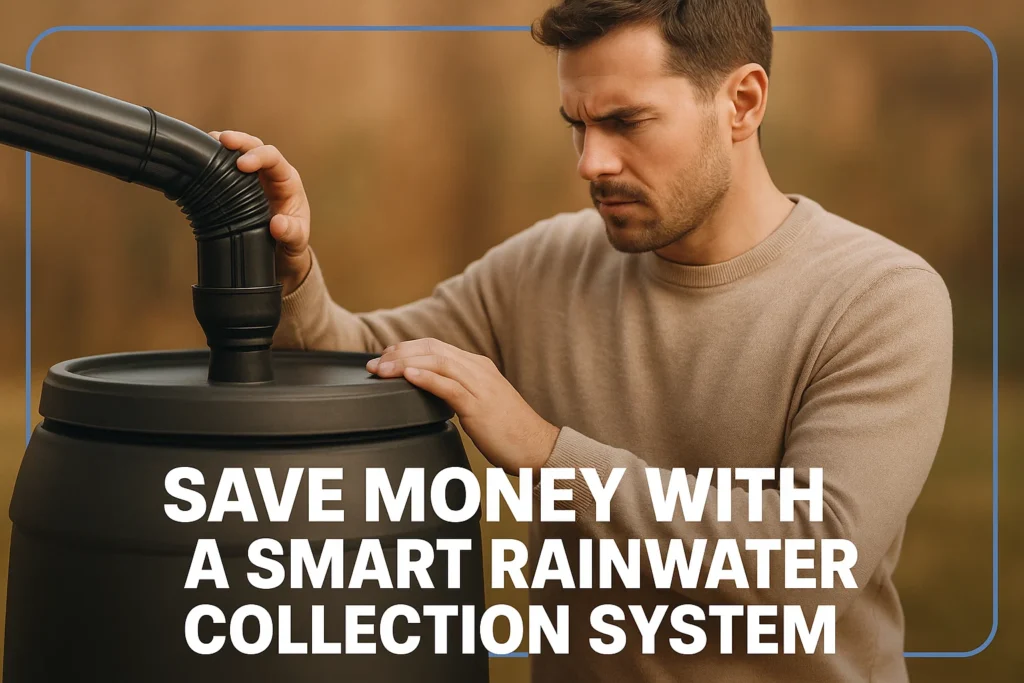Rainwater collection system is a green way of collecting rain water on the rooftop or any other surface and storing it to be used later. It is often referred to by the names rainwater capture system, rain collection system, or water collection system as well and includes such elements as gutters, downspouts, storage tanks, and filtration units.
The water collected can be utilized in outdoor irrigations, in watering the garden as well as indoors after proper treatment-this will help in reducing the reliance on municipal water supply, reduce the cost and have a positive impact on the environment. Lets have a look in detail:
How Does a Rainwater Collection System Work?
Your roof has gutters that are attached and the rainwater is directed into pipes that lead to a storage container like a barrel or underground tank. It can then be released either directly or by irrigation systems such as a rain drip irrigation kit or an underground irrigation system to gardens, which provides the water where it is wanted by the plants.
The system may include:
- Rain gutters and rain gutter water collection systems to drain the water effectively
- First flush diverters to eliminate initial debris-laden runoff
- Filters and treatment units to ensure the quality of water
- The storage tanks that your household needs and the patterns of rainfall
- This smart design helps to reduce water runoff, relieve soil erosion and also helps to save water until it is needed the most.
Key Components of a Rainwater Capture System
Following is a breakdown of the key elements of the design of a rain water collection system, how each of them functions, the average amount of water that each collects, and a cost comparison table to help you make your investment decisions:
1. Catchment Area (Collection Surface)
The rain is collected on the surface, which is usually your rooftop and the rain falls. The roofing material is also important; the smoother, non-toxic materials like metal or tiles make the water cleaner and less contaminated. Avoid materials such as asphalt shingles that have sealants that have a likelihood of leaching chemicals.
Collected water: The water that is usually harvested is 0.62 gallons of water per square foot of roof per inch of rain. As an illustration, a 1,000 sq ft roof will be able to gather about 620 gallons of water in one inch of rain.
Primary considerations: The roof will be in a slope and size that will determine the quality and quantity of the water collected.
2. Rain Gutters and Downspouts
Gutters are fitted on the roof borders and they divert the flow and convey rainwater into downspouts which direct the water to storage tanks or barrels. The right size will prevent overflow in case of heavy rains and leaf guards or screens will keep away the debris.
Water harvested: It is an ideal system that collects almost all the water that falls on the catchment area, except the water lost through evaporation or slight leakages.
Key considerations: In order to keep the water flowing, you should carry out routine clean up to remove the leaves and debris. To obtain the maximum flow and durability, aluminum round-bottom gutters are the best to use.
3. First Flush Diverter
This device redirects the first dirty runoff (first flush) which normally comprises of roof debris, bird droppings and dust, not to the storage tank. It directs this contaminated water to drain and it then only permits cleaner rainwater to go into the tank.
Collected water: The gallons (first flush volume) are flushed; the remaining water is collected.
Notes: The first flush diverter should be sized to the area of the roof; a typical size is approximately 0.02 gallons per square foot of catchment area.
4. Storage Tanks
Rainwater that is stored is stored in storage tanks. These can either be above-ground barrels or huge underground cisterns. The underground tanks save space and permit stability of temperature as compared to above-ground barrels that are easier to build and maintain.
Gathered water: The volume of the tank is dependent on the size of the tank. Tanks are between 50 gallons (small rain barrels) to more than 5,000 gallons (underground cisterns) in size depending on the intended purpose of the average household.
Key considerations: Select materials such as polyethylene, fiberglass or concrete. Tanks should be opaque so that the algae cannot grow and should be sealed so that mosquitoes and debris cannot enter.
5. Filtration & Treatment
Contaminants and particulates are removed. The multi-stage filtration may comprise mesh screens, sediment filters and activated carbon filters. Pathogens are killed by UV sterilization units as a means of purifying drinking water.
Collected water: The quantity of water collected is not reduced considerably but the quality and safety are increased considerably.
Important factors: The treatment depends on the purpose of the treatment is required to irrigate a garden or to supply an indoor potable supply. UV lamps need to be maintained and the filters need to be changed frequently.
6. Distribution System
It pumps the water in the tank to the areas of utilization. This may be as easy as taps on the rain barrels or linked irrigation systems such as drip irrigation kits or underground garden irrigation.
Water collected: The water collected is the water that can be utilized by the plants or appliances and this is determined by the efficiency of the distribution system.
Important factors: Drip irrigation systems are effective in terms of water consumption since water is directed to the roots, thus reducing evaporation and runoff.
Water Gathering Calculation Example
1,000 sq ft roof and 20 inches annual rainfall:
- Total rainfall volume: 1,000 sq ft×20 in×0.62 gallons/in=12,400 gallons/year1,000 sq ft×20 in×0.62 gallons/in=12,400 gallons/year
- Assuming 90% capture efficiency due to losses and first flush diversion:
- Usable harvested water = 12,400×0.9=11,160 gallons/year12,400×0.9=11,160 gallons/year
Key Methods for Integrating Rainwater with Irrigation Systems
1. Rain Drip Irrigation Kit (Drip Irrigation System)
Drip irrigation system is a network of tubes and small emitters that are used to transport the harvested rainwater to the root zones of plants.
These are slow dispensing water emitters and very precise to avoid wastage of water. The efficiency tends to be 90-95 percent.
Water efficiency:
One of the most water-efficient ways is drip irrigation which consumes 30-60 percent less water than conventional sprinklers due to the reduced evaporation, surface runoff, and overspray. The efficiency is usually 90-95 percent.
Typical application:
Perfect in gardens, flower beds, vegetable patches and orchards where specific watering of roots makes the plants healthier and saves on water.
Benefits:
- Conserves electricity and water
- Reduces weed growth as the roots are only supplied with water
- Minimizes the soil erosion and runoff
- More beautiful plants as the soil is always wet
Considerations:
They should be filtered to prevent clogging of the emitters. Maintenance Maintenance is routine cleaning and flushing of emitters.
2. Sprinkler Irrigation System ( Capture Rainwater for Garden )
The rainwater is then pumped into the underground pipes and discharged through sprinkler heads that spray the water across the lawn or garden to give out the same appearance as the rainwater.
It is not as efficient as drip irrigation, which is 50-70 percent efficient because of evaporation, wind drift and overland flow of water.
Water efficiency:
It suits well in lawns, big gardens and landscapes where a large area needs to be covered.
Typical application:
Easy to transform into other kinds of gardens
Benefits:
- Have the ability to be automated using timers and rain sensors
- It can be fitted into the current irrigation systems
- They can fit into the available irrigation systems
Considerations:
Needs to be filtered to avoid clogging of the nozzle. The low-angle, low-pressure sprinklers can be used to increase efficiency.
3. Subsurface Drip Irrigation (Subsurface Irrigation System in Gardens)
An underground irrigation system is a system whereby a network of drip tubes is buried and used to transport water to the roots of the plants.
The underground tanks or cisterns collect the rainwater making the water cool and reducing the growth of algae. They are very efficient and consume 90-95 percent of the water.
Water efficiency:
The underground site constrains the runoff and evaporation. They are ideal in medium to large gardens, landscaping schemes and where space saving and appearance are the primary issues.
Typical application:
Targeted irrigation at root level and water saving irrigation.
Benefits:
- Reduced weed growth and disease of plants because there is a dry soil surface
- Subterranean facilities to add to the ground of the ground
- Automation of the moisture controller and moisture sensors
- More costly to put in place and more sophisticated, it can be professionally designed and put in place.
Considerations:
Costs more to install, and is more complicated; it is usually professionally designed and installed.
Summary Table for Irrigation Methods Using Rainwater
| Method | Efficiency | Cost | Pros | Cons |
| Drip Irrigation System | 90-95% | $100 – $500+ | Precise watering, water-saving | Requires maintenance & filtration |
| Sprinkler Irrigation System | 50-70% | $200 – $1,000+ | Flexible, automated options | Less efficient, evaporation losses |
| Underground Irrigation System | 90-95% | $5,000 – $20,000+ | Discreet, very efficient | Higher upfront cost, complex install |
Why Install a Rain Water Collection System?
Pro tip: In addition to environmental benefit, a rainwater system will save you a lot of money on your water bills and give you a self-sustaining water supply in drought conditions or when the municipal water is shut off.
The greatest advantages are as follows:
- Saving on Costs: It is possible to save on water bills by using free rain water to irrigate gardens and other household activities in which water is not required to be drinkable.
- Conservation: The care of the local ecological systems through easing the pressure on the freshwater resources.
- Plant Health: Rainwater is milder and tends not to contain salts or chemicals that tap water might have, and is also good for the plants.
Conclusion
Rain water collection system is a good investment for sustainability and cost-efficiency. It does not matter whether you are putting in a simple rain barrel or a complex underground irrigation system driven by a rain drip irrigation kit; the financial and environmental advantages are obvious.
With proper planning of your system, incorporation of smart elements, and keeping it well maintained, you maximize the best of nature- rainwater for lawns.
FAQ’s
They are interchangeable terms and mean the same thing, i.e., systems that are designed to collect and store rainwater.
Rainwater can be sterilized and treated to be drinkable with the right filtration and treatment, such as UV sterilization. Otherwise, it is more suitable to be used as irrigation or non-consumptive.
An estimation of 0.62 gallons of yield per square foot of the roof per inch of rain is made. For example, one inch of rain can be collected in approximately 620 gallons in a 1,000 sq ft roof.
The effective operation is achieved by cleaning gutters and filters regularly, inspecting the tanks, and flushing sediment.
Though more expensive than the above-ground systems, underground systems are more space-efficient and water-conserving to the point where they can pay off the investment in the long run.



